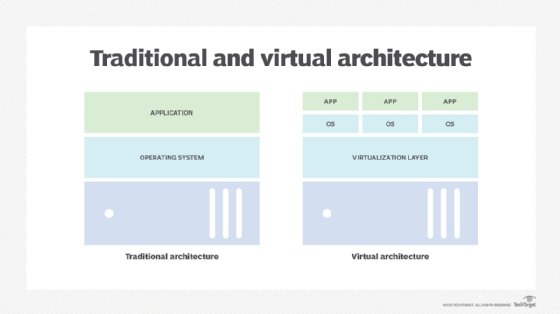guest operating system (guest OS)
What is a guest OS (guest operating system)?
A guest operating system is the operating system installed on either a virtual machine (VM) or partitioned disk. It is usually different from the host operating system (OS). Simply put, a host OS runs on hardware while a guest OS runs on a VM.
The OS installed on a computer that lets it communicate with its various hardware and software elements is its host OS. As the originally installed OS, the host OS is the system's "primary" OS.
In contrast, guest OS refers to a computer's "secondary" OS since it belongs to the VM or VMs set up on that machine using virtualization technology and a hypervisor tool. A Type 1 hypervisor, or bare-metal hypervisor, can create VMs, which can run guest OSes. The guest OS is delivered in a VM environment through a hypervisor. The guest OS runs inside the VM and provides another OS to run applications in the virtual environment, particularly applications incompatible with the host OS.
The guest OS can also be used for hardware abstraction. It ensures efficient resource management in the virtual environment and includes all required drivers for communication with virtual hardware.
How does a guest OS differ from a host OS?
A guest OS on a VM can be different from the host OS. But when the guest is deployed on a partitioned disk, the guest OS must be the same as the host OS. If the host is running Windows, any guest OS on a partitioned disk must also run Windows.
A guest OS is installed on and interacts with a VM, while the host OS is installed on and runs on the computer (host). Since the host OS runs on the host machine and the guest OS operates within it, it can limit file saving and other operations in the VM.
The host OS also interacts with the underlying hardware. There can be one or multiple guest OSes running on a computer, while the host is usually restricted to one OS.
A physical server can have multiple VMs, with each VM running its own guest OS. One guest OS could be Windows, while another could be Ubuntu or Linux, for example. The guest OS and host OS are separate and operate independently of each other. They can run simultaneously, although the host OS must be started first.

Another difference between a host OS and guest OS is that the former is responsible for managing all system resources, including memory and CPU. The host OS must also be compatible with all these resources and the VMs. The guest OS only manages the resources in its own VM. Additionally, it can only control the virtual resources the VM provides, while the host OS has complete control over both the physical system, its hardware and its VMs. Finally, to work as expected, the guest OS must only be compatible with the VM software and hardware abstraction layer the host OS provides.
Virtualization and guest OS
Virtualization technology lets a single computer run more than one OS at the same time. A single physical machine can be configured as multiple VMs. These VMs are isolated sections of hardware with storage, processing, memory and network capacity. Virtualization also allows resource sharing between the host OS and guest OS.

A guest OS provides an additional OS for applications and is required before a VM can be deployed. Developers can use it for testing without impacting anything outside that VM, such as data already in production use. An example of a guest OS would be Windows Server 2022 in a VM the VMware ESXi hypervisor created. Another example is Boot Camp, which lets Mac users run a Windows OS as the guest OS in a VM on their Mac.
Advantages of a guest operating system
Since a guest OS operates independently of the host OS, one of its significant advantages is that it supports programs or applications that are not compatible with or cannot run in the host OS. A guest OS features a "lean" build that helps alleviate memory and other system requirements in a virtualization environment.
A guest OS also comes in handy to test programs or applications and run them if they require different OSes on the same machine or hardware. Among the most common uses of a guest OS is to run multiple applications on the same hardware, especially if those applications require different OSes.
Installing a guest OS
Here are several ways to install a guest OS on a VM:
- Installer disc, such as a CD-ROM or DVD-ROM.
- Optical disc image (ISO) file, which is an OS file stored on an optical disc.
- Preboot execution environment (PXE) server, which is downloaded from the network.
With a PXE, it is possible to start a VM from a network device and remotely install a guest OS even without the OS installation media. As soon as the VM is turned on, it detects the PXE server. To enable PXE booting, the guest OS vendor must support the OS' PXE booting, the guest OS must be compatible with the hypervisor, and it must be included in the hypervisor's guest OS computability list. Also, the VM must have enough free disk space to store the system software and connect to network where the PXE server resides via a network adapter.
Installing a guest OS through an ISO image file is faster and more convenient than installing it via a media device.
Explore the difference between Type 1 and Type 2 hypervisors and what to know for your virtualized storage selection process. See how microservices and containers work apart and together, how to design your systems with virtualization architecture in mind and some examples of embedded hypervisors.






